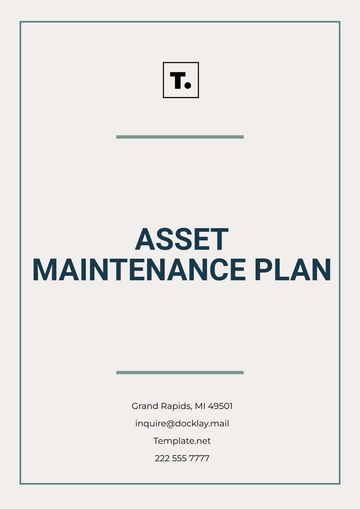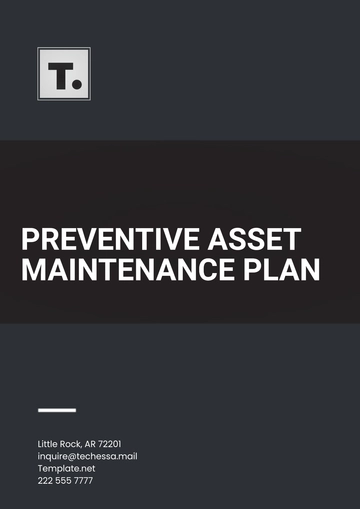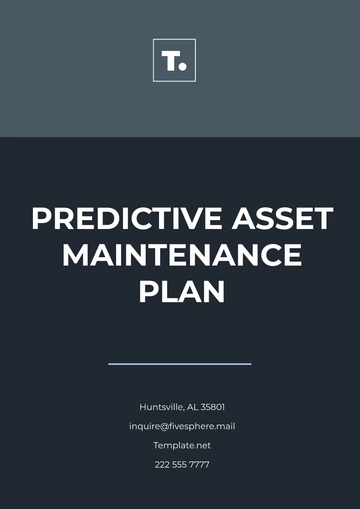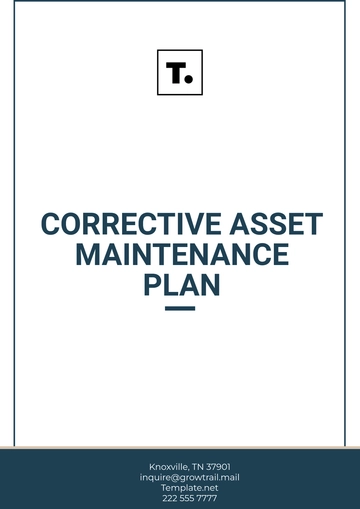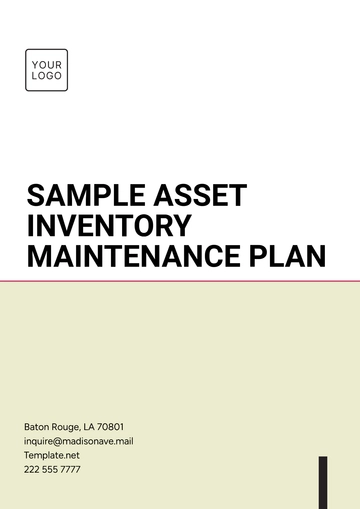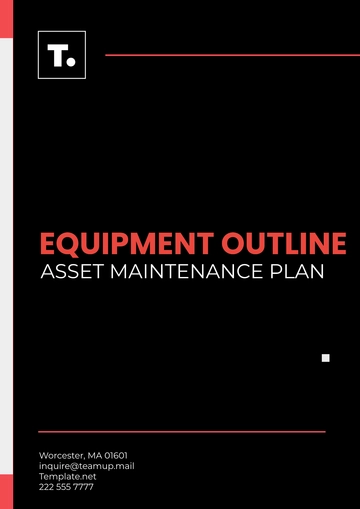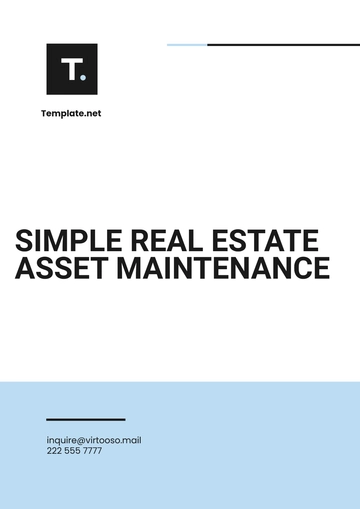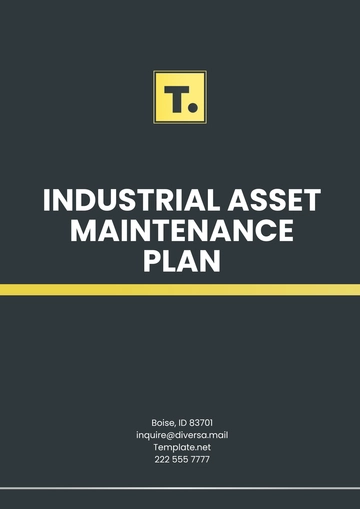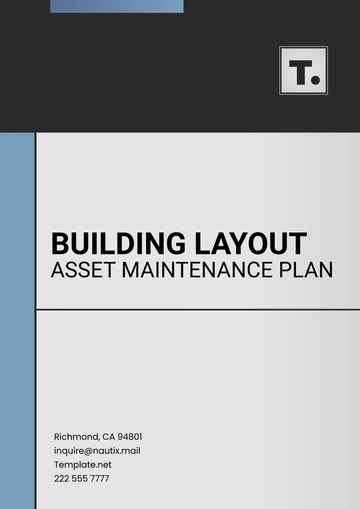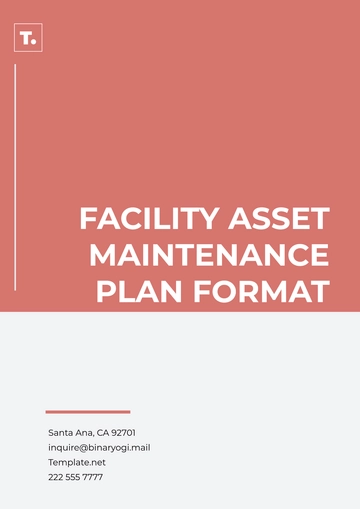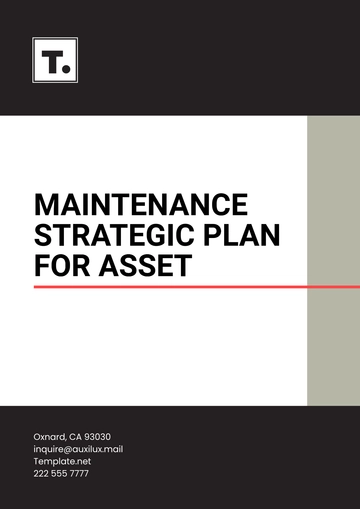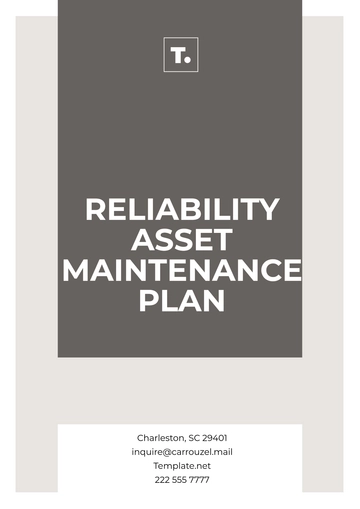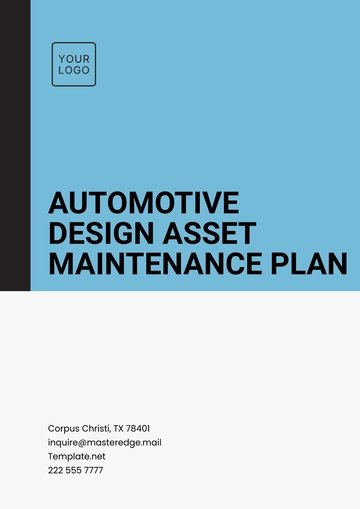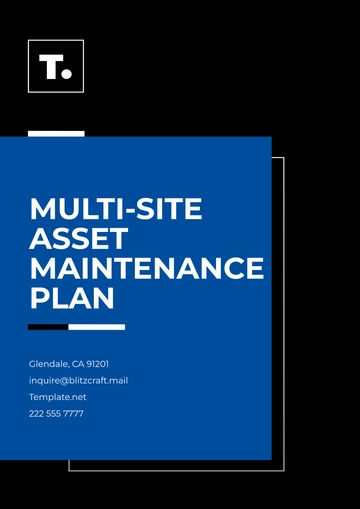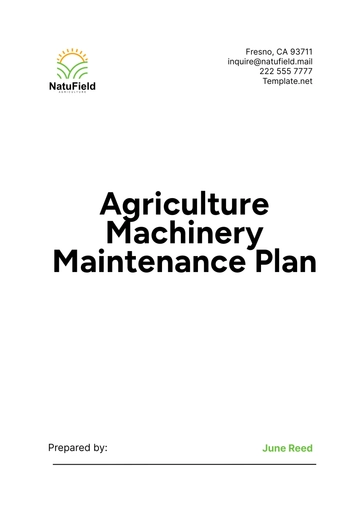Free Asset Maintenance Plan
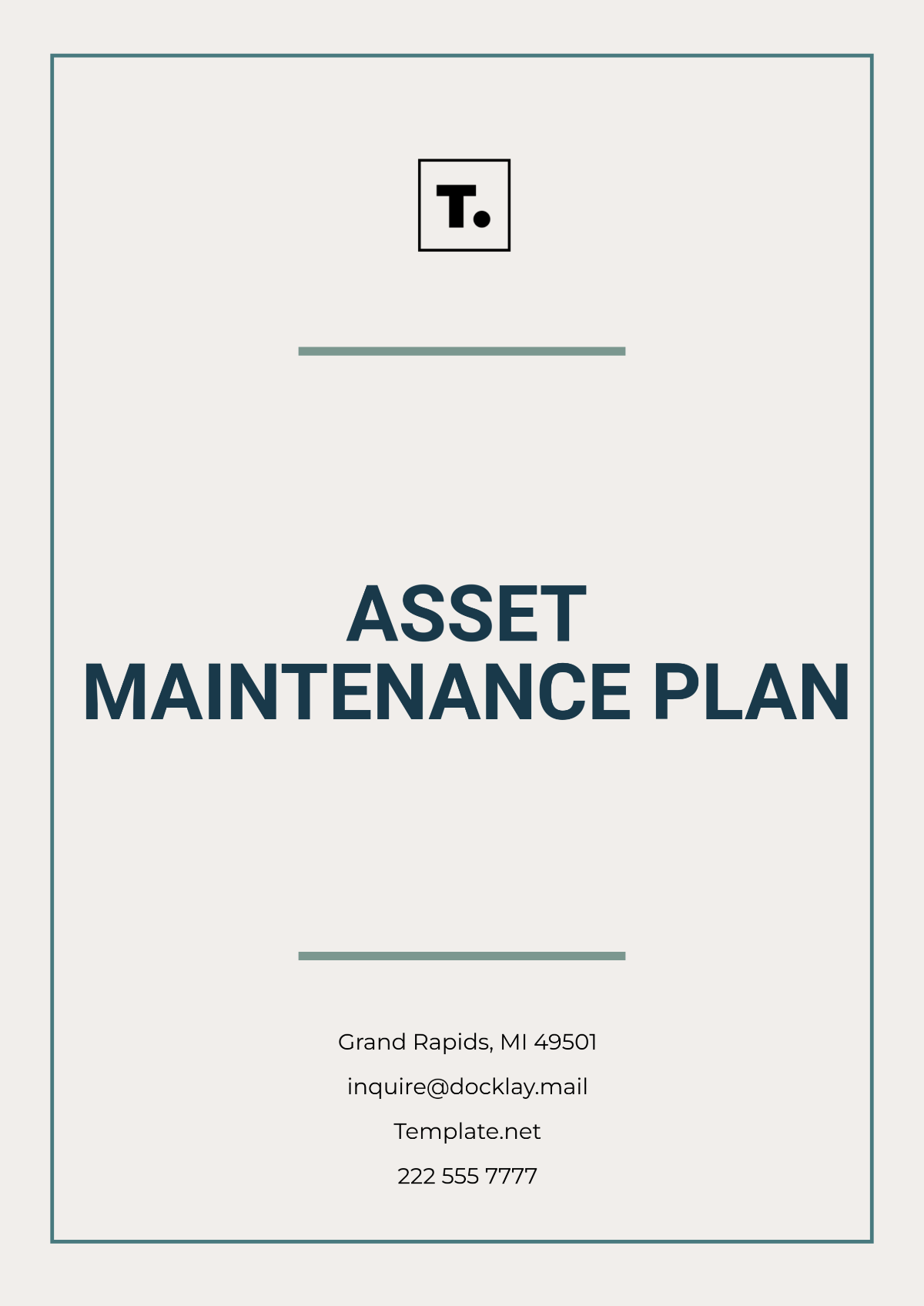
Prepared by: [Your Name]
Company: [Your Company Name]
Date: [Date]
I. Introduction/Overview
The Asset Maintenance Plan (AMP) serves as a systematic guide to ensure the proper upkeep, repair, and optimization of physical assets within the organization. The purpose of this plan is to increase the efficiency of the assets, reduce downtime, and maximize the lifespan of all critical equipment and infrastructure. This plan outlines best practices in routine inspections, preventive maintenance, and repairs, ensuring that all equipment operates at its peak performance levels.
This AMP is designed to be adaptable and flexible, focusing on an approach that minimizes operational disruptions and financial costs while maintaining high safety standards. By organizing maintenance activities into clear categories, the company will be able to extend the useful life of its assets and reduce the frequency of unexpected breakdowns.
II. Asset Inventory
Maintaining a detailed inventory of physical assets is essential for effective management and monitoring. The following list contains a selection of key assets within the organization, categorized by type and their respective maintenance schedules.
Asset ID | Asset Name | Location | Purchase Date | Value |
|---|---|---|---|---|
001 | Air Compressor | Plant 1 | January 1, 2050 | $15,000 |
002 | CNC Machine | Workshop A | June 21, 2050 | $50,000 |
003 | Electric Furnace | Plant 2 | March 12, 2055 | $80,000 |
004 | Robotic Arm | Assembly Line | August 29, 2059 | $120,000 |
005 | Cooling System | Warehouse | November 10, 2054 | $25,000 |
Example Breakdown of Assets
Air Compressor (AC1234): A critical asset for plant operations, it is used for powering machinery. Ensuring it runs smoothly will prevent interruptions in the production process.
CNC Machine (CNC5678): Integral to precision cutting operations, requiring high maintenance standards to ensure quality output.
Electric Furnace (EF8920): Used in heat treatment processes, regular inspections, and safety checks are crucial for maintaining operational efficiency.
III. Maintenance Schedules
The maintenance schedule specifies when and how maintenance activities are to be performed on each asset. It ensures that the timing of inspections, and preventive, and corrective maintenance is aligned with the asset’s operational needs.
A. Routine Maintenance
Routine maintenance tasks are performed frequently and aim to catch minor issues before they evolve into more serious problems. These tasks typically include inspections, lubrication, cleaning, and minor repairs.
Air Compressor (AC1234): Monthly inspection to check air filters and oil levels. Clean filters as necessary, check for leaks, and ensure proper air pressure levels.
CNC Machine (CNC5678): Weekly tool inspections, oiling of moving parts, and checking for alignment issues.
B. Preventive Maintenance
Preventive maintenance tasks are scheduled based on the manufacturer’s recommendations and past performance. These tasks are intended to avoid issues before they cause downtime.
Electric Furnace (EF8920): Quarterly inspection of wiring and heating elements. Replace worn-out components to prevent costly failures.
Cooling System (CS1023): Biannual inspection of coolant levels and pipe integrity. Replace filters and clean cooling fins to maintain optimal temperature regulation.
C. Corrective Maintenance
Corrective maintenance is executed when assets fail or show signs of malfunction. These maintenance tasks involve diagnosing the problem and restoring the asset to its functional state.
Robotic Arm (RA9012): If performance issues are detected, the arm’s joints will be realigned, and faulty actuators replaced.
CNC Machine (CNC5678): In case of a breakdown, the tool holder or spindle will be inspected for wear, and any damaged parts will be replaced to ensure continued precision.
IV. Tasks and Procedures
A. Inspection Procedures
Each asset undergoes a regular inspection to ensure it is operating correctly. These inspections check for wear and tear, misalignments, corrosion, and other early warning signs of potential failure.
Air Compressor (AC1234): Visual check for oil leaks and wear on the air hose. Check pressure gauges for accuracy. Verify the correct functioning of safety relief valves.
CNC Machine (CNC5678): Inspect all cutting tools for wear, ensuring they are sharp and free of damage. Check lubrication systems for consistency and accuracy.
B. Repair Tasks
When an asset shows signs of failure, immediate corrective repairs must be made. This can include part replacements, recalibrations, or adjustments to machinery to restore proper function.
Electric Furnace (EF8920): Replace heating elements if the furnace is not reaching optimal temperatures. Adjust the thermostat and check the wiring for damage.
Cooling System (CS1023): If the system is underperforming, inspect and replace damaged hoses, clean condenser coils, and ensure all pipes are free from obstructions.
V. Roles and Responsibilities
Clearly defined roles and responsibilities ensure that maintenance tasks are carried out efficiently and on time. Key personnel involved in the maintenance process are:
Maintenance Manager: Oversees the execution of the maintenance plan, assigns tasks, monitors performance, and manages the budget.
Technicians: Carry out daily, weekly, and monthly maintenance tasks as outlined in the schedule. They are responsible for diagnosing and repairing faults.
Asset Operators: Report faults, conduct basic inspections and perform minor maintenance tasks, such as cleaning or lubrication.
External Contractors: Specialized contractors may be called upon for more complex repairs or to replace large components that cannot be handled in-house.
VI. Budget and Costs
The budget section estimates the financial resources required for routine, preventive, and corrective maintenance activities. Below is an estimate of the annual maintenance costs for each category.
Task Category | Estimated Annual Cost |
|---|---|
Routine Maintenance | $10,000 |
Preventive Maintenance | $18,000 |
Corrective Maintenance | $12,000 |
Emergency Repairs | $7,000 |
Routine Maintenance: Covers inspections, minor repairs, and regular upkeep.
Preventive Maintenance: Includes planned component replacements, lubrication, and thorough inspections.
Corrective Maintenance: Costs associated with repairing or replacing broken parts after failure.
Emergency Repairs: Unforeseen costs for urgent repairs, including labor and expedited parts replacement.
VII. Performance Metrics
Key Performance Indicators (KPIs) are used to track the efficiency of the Asset Maintenance Plan. These metrics help to evaluate how well the maintenance activities are contributing to asset reliability and operational success.
Asset Uptime: The goal is for assets to operate at least 98% of the time without unplanned interruptions.
Maintenance Cost Variance: The maintenance costs should stay within 5% of the allocated budget.
Frequency of Breakdowns: Limit the frequency of breakdowns to fewer than 2 incidents per month for each major asset.
Mean Time to Repair (MTTR): Aim to reduce MTTR by implementing faster diagnostic and repair processes.
VIII. Compliance Requirements
Adherence to relevant safety standards, environmental regulations, and industry best practices is essential for ensuring both legal compliance and safe operations. Key compliance areas include:
OSHA Compliance: Ensures all maintenance activities follow OSHA standards for worker safety, especially when handling heavy machinery or hazardous materials.
Local Environmental Regulations: Ensures that maintenance activities do not adversely affect the environment, with special attention to waste disposal, emissions, and water usage.
Industry Standards (e.g., ISO 9001): Compliance with quality management standards that ensure all maintenance activities meet global best practices in asset management.
- 100% Customizable, free editor
- Access 1 Million+ Templates, photo’s & graphics
- Download or share as a template
- Click and replace photos, graphics, text, backgrounds
- Resize, crop, AI write & more
- Access advanced editor
Streamline your maintenance process with our Asset Maintenance Plan Template from Template.net. This fully editable and customizable template provides a comprehensive scheduling framework for asset maintenance tracking. Easily define tasks, timelines, and procedures to ensure optimal asset performance. Editable in our Ai Editor Tool, you can tailor this template to fit your business needs, making it an essential tool for managing asset upkeep efficiently.
You may also like
- Finance Plan
- Construction Plan
- Sales Plan
- Development Plan
- Career Plan
- Budget Plan
- HR Plan
- Education Plan
- Transition Plan
- Work Plan
- Training Plan
- Communication Plan
- Operation Plan
- Health And Safety Plan
- Strategy Plan
- Professional Development Plan
- Advertising Plan
- Risk Management Plan
- Restaurant Plan
- School Plan
- Nursing Home Patient Care Plan
- Nursing Care Plan
- Plan Event
- Startup Plan
- Social Media Plan
- Staffing Plan
- Annual Plan
- Content Plan
- Payment Plan
- Implementation Plan
- Hotel Plan
- Workout Plan
- Accounting Plan
- Campaign Plan
- Essay Plan
- 30 60 90 Day Plan
- Research Plan
- Recruitment Plan
- 90 Day Plan
- Quarterly Plan
- Emergency Plan
- 5 Year Plan
- Gym Plan
- Personal Plan
- IT and Software Plan
- Treatment Plan
- Real Estate Plan
- Law Firm Plan
- Healthcare Plan
- Improvement Plan
- Media Plan
- 5 Year Business Plan
- Learning Plan
- Marketing Campaign Plan
- Travel Agency Plan
- Cleaning Services Plan
- Interior Design Plan
- Performance Plan
- PR Plan
- Birth Plan
- Life Plan
- SEO Plan
- Disaster Recovery Plan
- Continuity Plan
- Launch Plan
- Legal Plan
- Behavior Plan
- Performance Improvement Plan
- Salon Plan
- Security Plan
- Security Management Plan
- Employee Development Plan
- Quality Plan
- Service Improvement Plan
- Growth Plan
- Incident Response Plan
- Basketball Plan
- Emergency Action Plan
- Product Launch Plan
- Spa Plan
- Employee Training Plan
- Data Analysis Plan
- Employee Action Plan
- Territory Plan
- Audit Plan
- Classroom Plan
- Activity Plan
- Parenting Plan
- Care Plan
- Project Execution Plan
- Exercise Plan
- Internship Plan
- Software Development Plan
- Continuous Improvement Plan
- Leave Plan
- 90 Day Sales Plan
- Advertising Agency Plan
- Employee Transition Plan
- Smart Action Plan
- Workplace Safety Plan
- Behavior Change Plan
- Contingency Plan
- Continuity of Operations Plan
- Health Plan
- Quality Control Plan
- Self Plan
- Sports Development Plan
- Change Management Plan
- Ecommerce Plan
- Personal Financial Plan
- Process Improvement Plan
- 30-60-90 Day Sales Plan
- Crisis Management Plan
- Engagement Plan
- Execution Plan
- Pandemic Plan
- Quality Assurance Plan
- Service Continuity Plan
- Agile Project Plan
- Fundraising Plan
- Job Transition Plan
- Asset Maintenance Plan
- Maintenance Plan
- Software Test Plan
- Staff Training and Development Plan
- 3 Year Plan
- Brand Activation Plan
- Release Plan
- Resource Plan
- Risk Mitigation Plan
- Teacher Plan
- 30 60 90 Day Plan for New Manager
- Food Safety Plan
- Food Truck Plan
- Hiring Plan
- Quality Management Plan
- Wellness Plan
- Behavior Intervention Plan
- Bonus Plan
- Investment Plan
- Maternity Leave Plan
- Pandemic Response Plan
- Succession Planning
- Coaching Plan
- Configuration Management Plan
- Remote Work Plan
- Self Care Plan
- Teaching Plan
- 100-Day Plan
- HACCP Plan
- Student Plan
- Sustainability Plan
- 30 60 90 Day Plan for Interview
- Access Plan
- Site Specific Safety Plan
